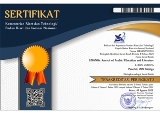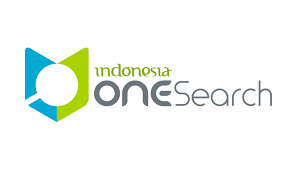Taṭwīr Wasīlat Vīdiyū al-Rusūm al-Mutaḥarrikah li-Tarqiyat Injāz Taʿlīm al-Mufradāt ladá at-Ṭullāb fī al-Madrasah al-Ibtidā’īyah
Abstract
Keywords
Full Text:
PDFReferences
Albantani, A. M., & Madkur, A. (2017). Musyahadat Al Fidyu: Youtube-Based Teaching and Learning of Arabic as Foreign Language (AFL). Dinamika Ilmu, 17(2), 291–308. http://doi.org/10.21093/di.v17i2.854
Alshraideh, D. S. (2021). EFL Learners’ and Teachers’ Perception toward the Use of Online Videos in EFL Classes. Arab World English Journal, 12(1), 215–228. http://doi.org/10.24093/awej/vol12no1.15
Andrä, C., Mathias, B., Schwager, A., Macedonia, M., & von Kriegstein, K. (2020). Learning Foreign Language Vocabulary with Gestures and Pictures Enhances Vocabulary Memory for Several Months Post-Learning in Eight-Year-Old School Children. Educational Psychology Review, 32(3), 815–850. http://doi.org/10.1007/s10648-020-09527-z
Asyrofi, S., & Pransiska, T. (2019). Desain Pembelajaran Bahasa Arab. Yogyakarta: Pustaka Ilmu.
Baharudin, H., & Ismail, Z. (2014). Vocabulary learning strategies and arabic vocabulary size among pre-university students in Malaysia. International Education Studies, 7(13), 219–226. http://doi.org/10.5539/IES.V7N13P219
D.E., A. (2017). Kamus Bahasa Indonesia. Jakarta: Grasindo.
Daryanto. (2010). Media Pembelajaran. Yogyakarta: Gava Media.
Globe, S. (2017). Al-Wasā’il al-Taʿlīmīyah. Mecca: Dār Khālid al-Liḥyānī lil-Nashr wa-al-Tawzīʿ.
Hadi, H. ur R., & Guo, X. (2020). A survey of beliefs and vocabulary learning strategies adopted by EFL learners at Shaikh Zayed University. Cogent Education, 7(1). http://doi.org/10.1080/2331186X.2020.1829803
Hamid, A. (2013). Mengukur Kemampuan Berbahasa Arab. Malang: UIN Maliki Press.
Ḥarāḥshah, I. M. ʿAlī. (2007). Al-Mahārāt al-Qirā’īyah wa-Ṭuruq Tadrīsihā bayna al-Naẓarīyah wa-al-Taṭbīq. Amman: Dār al-Khuzāmá.
Husseianali, G. (2005). Why are you Learning Arabic? Orientations, Motivation and Achievement. Texas Papers on Foreign Language Education, 99–115. Retrieved from https://eric.ed.gov/?id=ED532415
Kementerian Agama. Keputusan Menteri Agama Tentang Kurikulum PAI dan Bahasa Arab pada Madrasah, Pub. L. No. 183 (2019). Indonesia: Direktorat KSKK Madrasah, Direktorat Jenderal Pendidikan Islam.
Masrai, A., & Milton, J. (2019). How many words do you need to speak Arabic? An Arabic vocabulary size test. The Language Learning Journal, 47(5), 519–536. http://doi.org/10.1080/09571736.2016.1258720
Mills, N., & Belnap, R. K. (2017). Beliefs, Motivation, and Engagement. In K. M. Wahba, L. England, & Z. A. Taha (Eds.), Handbook for Arabic Language Teaching Professionals in the 21st Century (Vol. 2). Abingdon: Routledge. http://doi.org/10.4324/9781315676111.ch5
Musthofa, S. (2017). Strategi Pembelajaran Bahasa Arab Inovatif. Malang: UIN-Maliki Press.
Ponza, P. J. R., Jampel, I. N., & Sudarma, I. K. (2018). Pengembangan Media Video Animasi pada Pembelajaran Siswa Kelas IV di Sekolah Dasar. Jurnal Edutech Undiksha, 6(1), 9–19. http://doi.org/10.23887/jeu.v6i1.20257
Pribadi, B. A. (2017). Media & Teknologi dalam Pembelajaran. Jakarta: Kencana.
Purnama, B. E. (2013). Konsep Dasar Multimedia. Yogyakarta: Graha Ilmu.
Rahimi, N. M., Nasri, N., & Samihah, S. (2021). Promoting Digital Learning Environment in Arabic Language Education: The Use of Animated Video (AV) For Vocabulary Acquisition among Primary School Students. Ijaz Arabi Journal of Arabic Learning, 4(3), 548–556. http://doi.org/10.18860/ijazarabi.v4i3.12941
Richards, J. C., & Renandya, W. A. (2002). Methodology in Language Teaching: An Anthology of Current Practice. Methodology in language teaching : an anthology of current practice. Cambridge: Cambridge University Press.
Ritonga, M., Lahmi, A., Sartika, F., Zubaidah, Z., & Annova, F. (2021). The Using YouTube and Google Drive as Arabic Learning Media at Covid-19 Period. In Proceedings of the 1st International Conference on Education, Humanities, Health and Agriculture, ICEHHA 2021. Flores: EAI. http://doi.org/10.4108/eai.3-6-2021.2310751
Rosyidi, A. W., & Ni’mah, M. (2018). Memahami Konsep Dasar Pembelajaran Bahasa Arab. Malang: UIN-Maliki Press.
Rusman, Kurniawan, D., & Riyana, C. (2015). Pembelajaran Berbasis Teknologi Informasi dan Komunikasi: Mengembangkan Profesionalitas Guru, (Jakarta : PT. Rajagrafindo Persada, 2015). Jakarta: Raja Grafindo Persada.
Salahuddin, H., Fauzi, M. F., & Mauludiyah, L. (2021). Effectiveness of Arabic Video Animation in Improving the Mastery of Arabic Vocabulary for Students of Islamic Junior School. International Journal of Arabic Language Teaching, 2(2), 149–161. http://doi.org/10.32332/ijalt.v2i02.2499
Sambas, S. (2004). Komunikasi dan Penyiaran Islam. Bandung: Benang Merah Press.
Sprenger, M. (2018). Taʿlīm al-Mufradāt: Kayfa Uʿallim al-Mufradāt bi-Fāʿilīyah Raghma Maḥdūdīyat al-Waqt? Dammam: Dār al-Kitāb al-Tarbawī lil-Nashr wa-al-Tawzīʿ.
Sukiman. (2012). Pengembangan Media Pembelajaran. Yogyakarta: Pustaka Insani Madani.
Wahyudin, D. (2020). Metodologi Pembelajaran Bahasa Arab (Berdasarkan teori Unit dan Parsial). Bandung: PT. Remaja Rosdakarya.
Yanto, E. S., & Nugraha, S. I. (2018). Video viewing as a mediation of learning content-based vocabulary: Assisting students in understanding disciplinary vocabulary in context. Indonesian Journal of Applied Linguistics, 8(2), 316 – 324. http://doi.org/10.17509/ijal.v8i2.13278
DOI: https://doi.org/10.18326/lisania.v6i2.213-234
Refbacks
- There are currently no refbacks.
Copyright (c) 2022 Fikrotul Khusnia, Naifah Naifah, Rosidi Rosidi

This work is licensed under a Creative Commons Attribution-ShareAlike 4.0 International License.
View My Stats








